Taxation Assignment: Residency, Business Income, and Tax Liabilities
VerifiedAdded on 2022/10/17
|11
|2357
|16
Case Study
AI Summary
This case study analyzes Australian taxation, focusing on residency, income, and business activities. Part A examines Rachel, a medical practitioner from London, and determines her tax residency status based on ATO guidelines, considering her family ties, bank accounts, and the 183-day test. It assesses her income from various sources, including foreign interest and Australian salary, to determine her tax liabilities. Part B analyzes John's residency status, comparing his situation to the Harding v Commissioner of Taxation case. Case study 2 explores the distinction between a hobby and a business for tax purposes, using Nadine's painting activity as an example. Case study 3 discusses the taxation of workers, including employees and contract workers, PAYG, payroll tax, and fringe benefits tax. Finally, the case study provides an accounting analysis of Sam's financial year, calculating his total liabilities based on his receipts and payments, and determining his taxable income.
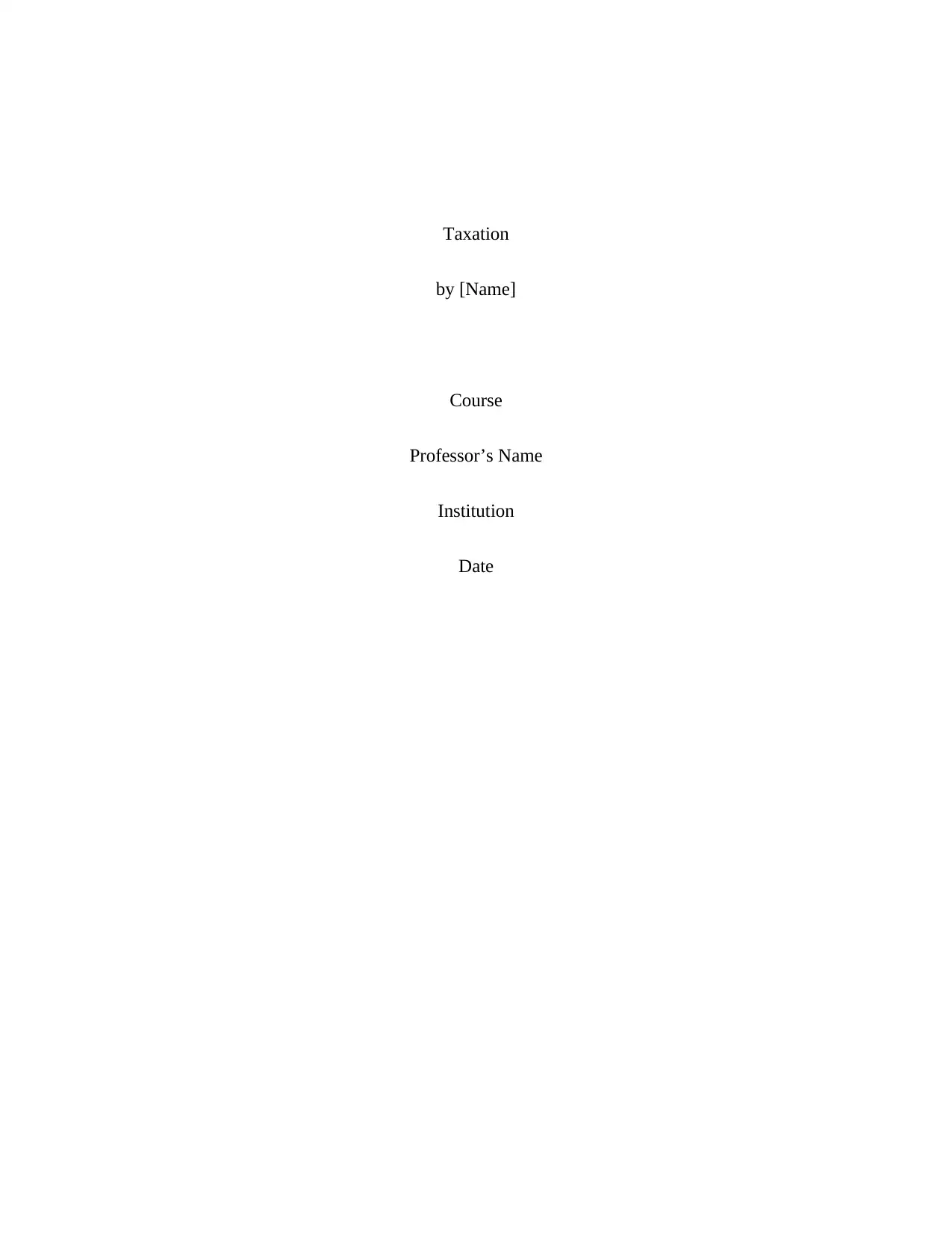
Taxation
by [Name]
Course
Professor’s Name
Institution
Date
by [Name]
Course
Professor’s Name
Institution
Date
Paraphrase This Document
Need a fresh take? Get an instant paraphrase of this document with our AI Paraphraser
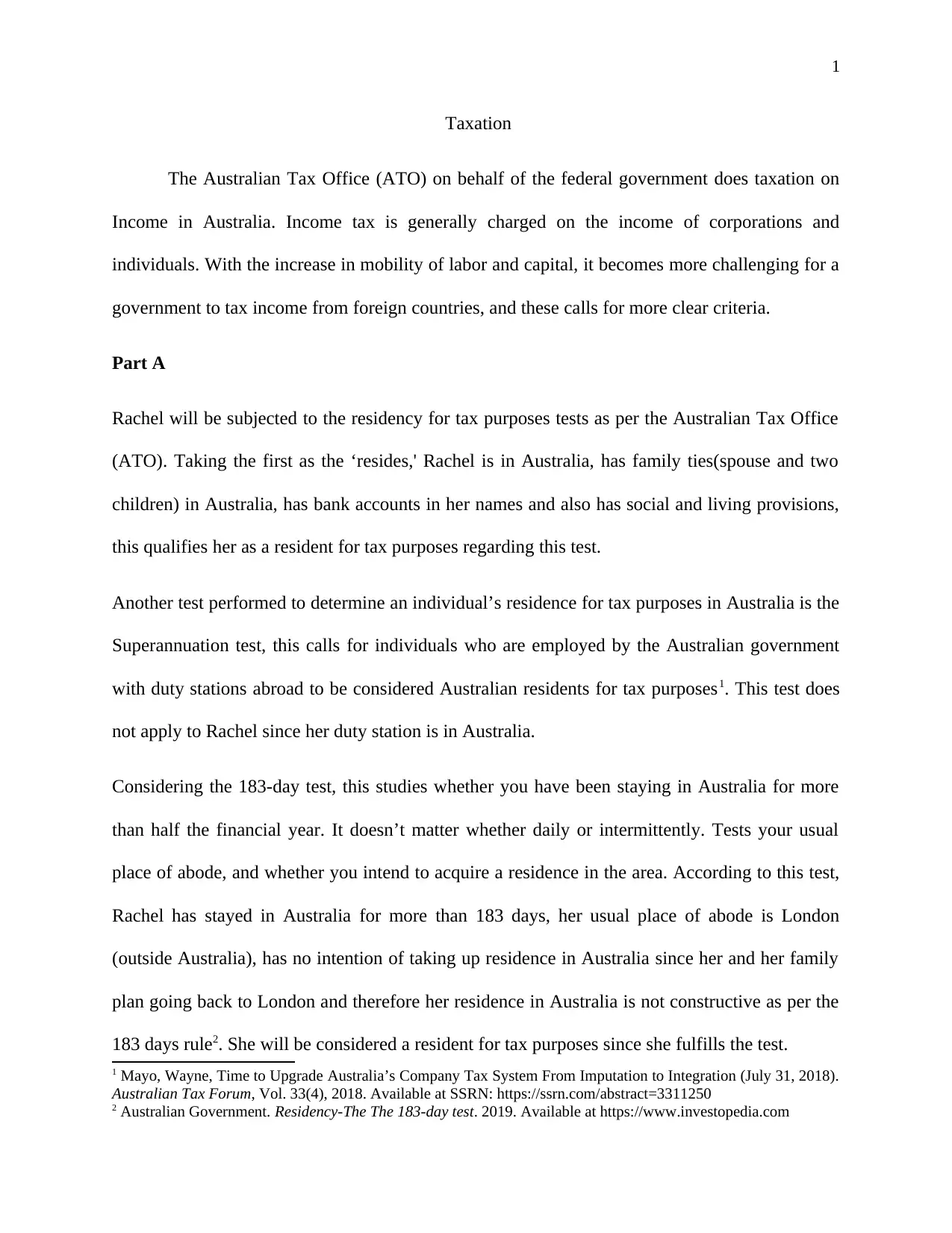
1
Taxation
The Australian Tax Office (ATO) on behalf of the federal government does taxation on
Income in Australia. Income tax is generally charged on the income of corporations and
individuals. With the increase in mobility of labor and capital, it becomes more challenging for a
government to tax income from foreign countries, and these calls for more clear criteria.
Part A
Rachel will be subjected to the residency for tax purposes tests as per the Australian Tax Office
(ATO). Taking the first as the ‘resides,' Rachel is in Australia, has family ties(spouse and two
children) in Australia, has bank accounts in her names and also has social and living provisions,
this qualifies her as a resident for tax purposes regarding this test.
Another test performed to determine an individual’s residence for tax purposes in Australia is the
Superannuation test, this calls for individuals who are employed by the Australian government
with duty stations abroad to be considered Australian residents for tax purposes1. This test does
not apply to Rachel since her duty station is in Australia.
Considering the 183-day test, this studies whether you have been staying in Australia for more
than half the financial year. It doesn’t matter whether daily or intermittently. Tests your usual
place of abode, and whether you intend to acquire a residence in the area. According to this test,
Rachel has stayed in Australia for more than 183 days, her usual place of abode is London
(outside Australia), has no intention of taking up residence in Australia since her and her family
plan going back to London and therefore her residence in Australia is not constructive as per the
183 days rule2. She will be considered a resident for tax purposes since she fulfills the test.
1 Mayo, Wayne, Time to Upgrade Australia’s Company Tax System From Imputation to Integration (July 31, 2018).
Australian Tax Forum, Vol. 33(4), 2018. Available at SSRN: https://ssrn.com/abstract=3311250
2 Australian Government. Residency-The The 183-day test. 2019. Available at https://www.investopedia.com
Taxation
The Australian Tax Office (ATO) on behalf of the federal government does taxation on
Income in Australia. Income tax is generally charged on the income of corporations and
individuals. With the increase in mobility of labor and capital, it becomes more challenging for a
government to tax income from foreign countries, and these calls for more clear criteria.
Part A
Rachel will be subjected to the residency for tax purposes tests as per the Australian Tax Office
(ATO). Taking the first as the ‘resides,' Rachel is in Australia, has family ties(spouse and two
children) in Australia, has bank accounts in her names and also has social and living provisions,
this qualifies her as a resident for tax purposes regarding this test.
Another test performed to determine an individual’s residence for tax purposes in Australia is the
Superannuation test, this calls for individuals who are employed by the Australian government
with duty stations abroad to be considered Australian residents for tax purposes1. This test does
not apply to Rachel since her duty station is in Australia.
Considering the 183-day test, this studies whether you have been staying in Australia for more
than half the financial year. It doesn’t matter whether daily or intermittently. Tests your usual
place of abode, and whether you intend to acquire a residence in the area. According to this test,
Rachel has stayed in Australia for more than 183 days, her usual place of abode is London
(outside Australia), has no intention of taking up residence in Australia since her and her family
plan going back to London and therefore her residence in Australia is not constructive as per the
183 days rule2. She will be considered a resident for tax purposes since she fulfills the test.
1 Mayo, Wayne, Time to Upgrade Australia’s Company Tax System From Imputation to Integration (July 31, 2018).
Australian Tax Forum, Vol. 33(4), 2018. Available at SSRN: https://ssrn.com/abstract=3311250
2 Australian Government. Residency-The The 183-day test. 2019. Available at https://www.investopedia.com
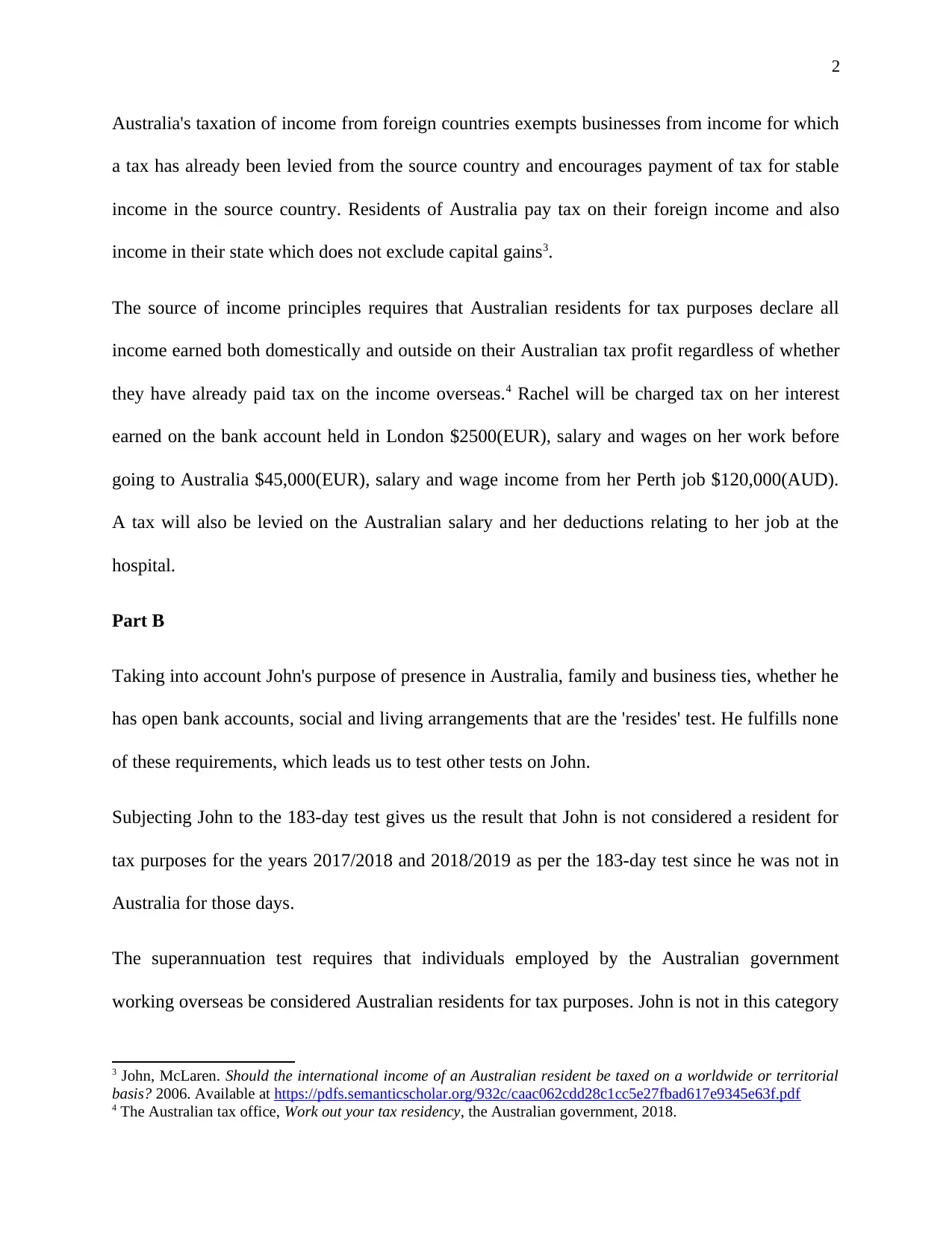
2
Australia's taxation of income from foreign countries exempts businesses from income for which
a tax has already been levied from the source country and encourages payment of tax for stable
income in the source country. Residents of Australia pay tax on their foreign income and also
income in their state which does not exclude capital gains3.
The source of income principles requires that Australian residents for tax purposes declare all
income earned both domestically and outside on their Australian tax profit regardless of whether
they have already paid tax on the income overseas.4 Rachel will be charged tax on her interest
earned on the bank account held in London $2500(EUR), salary and wages on her work before
going to Australia $45,000(EUR), salary and wage income from her Perth job $120,000(AUD).
A tax will also be levied on the Australian salary and her deductions relating to her job at the
hospital.
Part B
Taking into account John's purpose of presence in Australia, family and business ties, whether he
has open bank accounts, social and living arrangements that are the 'resides' test. He fulfills none
of these requirements, which leads us to test other tests on John.
Subjecting John to the 183-day test gives us the result that John is not considered a resident for
tax purposes for the years 2017/2018 and 2018/2019 as per the 183-day test since he was not in
Australia for those days.
The superannuation test requires that individuals employed by the Australian government
working overseas be considered Australian residents for tax purposes. John is not in this category
3 John, McLaren. Should the international income of an Australian resident be taxed on a worldwide or territorial
basis? 2006. Available at https://pdfs.semanticscholar.org/932c/caac062cdd28c1cc5e27fbad617e9345e63f.pdf
4 The Australian tax office, Work out your tax residency, the Australian government, 2018.
Australia's taxation of income from foreign countries exempts businesses from income for which
a tax has already been levied from the source country and encourages payment of tax for stable
income in the source country. Residents of Australia pay tax on their foreign income and also
income in their state which does not exclude capital gains3.
The source of income principles requires that Australian residents for tax purposes declare all
income earned both domestically and outside on their Australian tax profit regardless of whether
they have already paid tax on the income overseas.4 Rachel will be charged tax on her interest
earned on the bank account held in London $2500(EUR), salary and wages on her work before
going to Australia $45,000(EUR), salary and wage income from her Perth job $120,000(AUD).
A tax will also be levied on the Australian salary and her deductions relating to her job at the
hospital.
Part B
Taking into account John's purpose of presence in Australia, family and business ties, whether he
has open bank accounts, social and living arrangements that are the 'resides' test. He fulfills none
of these requirements, which leads us to test other tests on John.
Subjecting John to the 183-day test gives us the result that John is not considered a resident for
tax purposes for the years 2017/2018 and 2018/2019 as per the 183-day test since he was not in
Australia for those days.
The superannuation test requires that individuals employed by the Australian government
working overseas be considered Australian residents for tax purposes. John is not in this category
3 John, McLaren. Should the international income of an Australian resident be taxed on a worldwide or territorial
basis? 2006. Available at https://pdfs.semanticscholar.org/932c/caac062cdd28c1cc5e27fbad617e9345e63f.pdf
4 The Australian tax office, Work out your tax residency, the Australian government, 2018.
⊘ This is a preview!⊘
Do you want full access?
Subscribe today to unlock all pages.

Trusted by 1+ million students worldwide
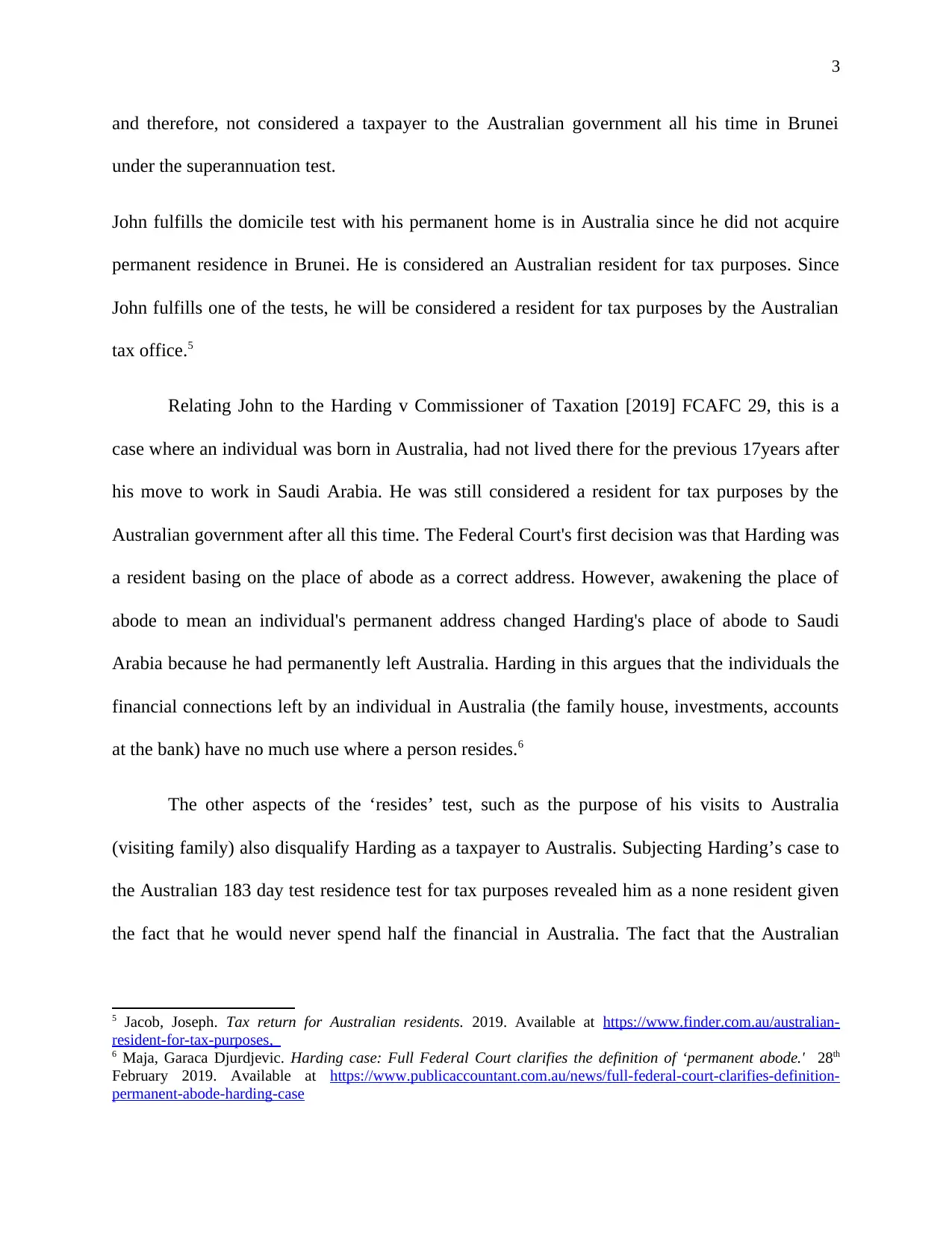
3
and therefore, not considered a taxpayer to the Australian government all his time in Brunei
under the superannuation test.
John fulfills the domicile test with his permanent home is in Australia since he did not acquire
permanent residence in Brunei. He is considered an Australian resident for tax purposes. Since
John fulfills one of the tests, he will be considered a resident for tax purposes by the Australian
tax office.5
Relating John to the Harding v Commissioner of Taxation [2019] FCAFC 29, this is a
case where an individual was born in Australia, had not lived there for the previous 17years after
his move to work in Saudi Arabia. He was still considered a resident for tax purposes by the
Australian government after all this time. The Federal Court's first decision was that Harding was
a resident basing on the place of abode as a correct address. However, awakening the place of
abode to mean an individual's permanent address changed Harding's place of abode to Saudi
Arabia because he had permanently left Australia. Harding in this argues that the individuals the
financial connections left by an individual in Australia (the family house, investments, accounts
at the bank) have no much use where a person resides.6
The other aspects of the ‘resides’ test, such as the purpose of his visits to Australia
(visiting family) also disqualify Harding as a taxpayer to Australis. Subjecting Harding’s case to
the Australian 183 day test residence test for tax purposes revealed him as a none resident given
the fact that he would never spend half the financial in Australia. The fact that the Australian
5 Jacob, Joseph. Tax return for Australian residents. 2019. Available at https://www.finder.com.au/australian-
resident-for-tax-purposes,
6 Maja, Garaca Djurdjevic. Harding case: Full Federal Court clarifies the definition of ‘permanent abode.' 28th
February 2019. Available at https://www.publicaccountant.com.au/news/full-federal-court-clarifies-definition-
permanent-abode-harding-case
and therefore, not considered a taxpayer to the Australian government all his time in Brunei
under the superannuation test.
John fulfills the domicile test with his permanent home is in Australia since he did not acquire
permanent residence in Brunei. He is considered an Australian resident for tax purposes. Since
John fulfills one of the tests, he will be considered a resident for tax purposes by the Australian
tax office.5
Relating John to the Harding v Commissioner of Taxation [2019] FCAFC 29, this is a
case where an individual was born in Australia, had not lived there for the previous 17years after
his move to work in Saudi Arabia. He was still considered a resident for tax purposes by the
Australian government after all this time. The Federal Court's first decision was that Harding was
a resident basing on the place of abode as a correct address. However, awakening the place of
abode to mean an individual's permanent address changed Harding's place of abode to Saudi
Arabia because he had permanently left Australia. Harding in this argues that the individuals the
financial connections left by an individual in Australia (the family house, investments, accounts
at the bank) have no much use where a person resides.6
The other aspects of the ‘resides’ test, such as the purpose of his visits to Australia
(visiting family) also disqualify Harding as a taxpayer to Australis. Subjecting Harding’s case to
the Australian 183 day test residence test for tax purposes revealed him as a none resident given
the fact that he would never spend half the financial in Australia. The fact that the Australian
5 Jacob, Joseph. Tax return for Australian residents. 2019. Available at https://www.finder.com.au/australian-
resident-for-tax-purposes,
6 Maja, Garaca Djurdjevic. Harding case: Full Federal Court clarifies the definition of ‘permanent abode.' 28th
February 2019. Available at https://www.publicaccountant.com.au/news/full-federal-court-clarifies-definition-
permanent-abode-harding-case
Paraphrase This Document
Need a fresh take? Get an instant paraphrase of this document with our AI Paraphraser
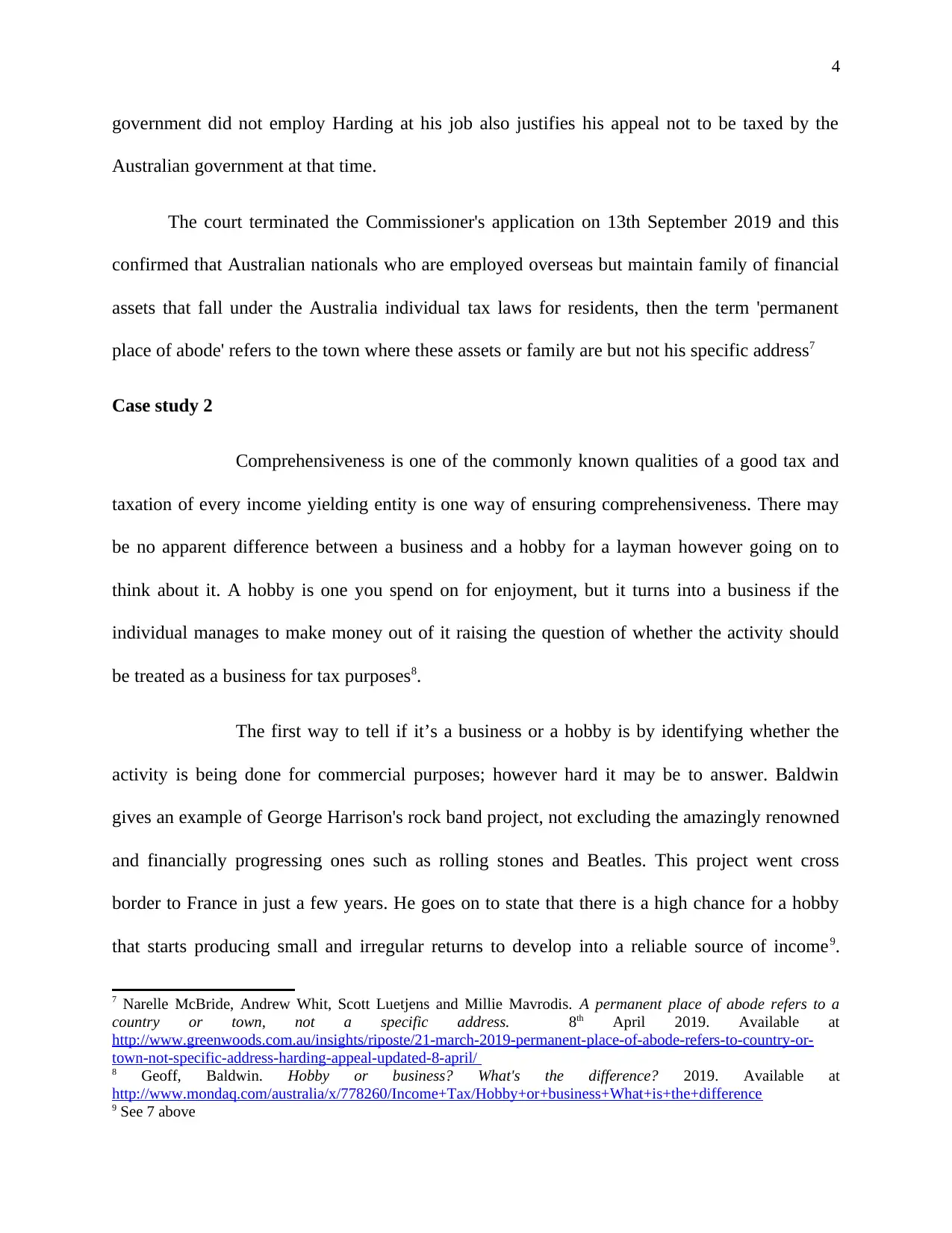
4
government did not employ Harding at his job also justifies his appeal not to be taxed by the
Australian government at that time.
The court terminated the Commissioner's application on 13th September 2019 and this
confirmed that Australian nationals who are employed overseas but maintain family of financial
assets that fall under the Australia individual tax laws for residents, then the term 'permanent
place of abode' refers to the town where these assets or family are but not his specific address7
Case study 2
Comprehensiveness is one of the commonly known qualities of a good tax and
taxation of every income yielding entity is one way of ensuring comprehensiveness. There may
be no apparent difference between a business and a hobby for a layman however going on to
think about it. A hobby is one you spend on for enjoyment, but it turns into a business if the
individual manages to make money out of it raising the question of whether the activity should
be treated as a business for tax purposes8.
The first way to tell if it’s a business or a hobby is by identifying whether the
activity is being done for commercial purposes; however hard it may be to answer. Baldwin
gives an example of George Harrison's rock band project, not excluding the amazingly renowned
and financially progressing ones such as rolling stones and Beatles. This project went cross
border to France in just a few years. He goes on to state that there is a high chance for a hobby
that starts producing small and irregular returns to develop into a reliable source of income9.
7 Narelle McBride, Andrew Whit, Scott Luetjens and Millie Mavrodis. A permanent place of abode refers to a
country or town, not a specific address. 8th April 2019. Available at
http://www.greenwoods.com.au/insights/riposte/21-march-2019-permanent-place-of-abode-refers-to-country-or-
town-not-specific-address-harding-appeal-updated-8-april/
8 Geoff, Baldwin. Hobby or business? What's the difference? 2019. Available at
http://www.mondaq.com/australia/x/778260/Income+Tax/Hobby+or+business+What+is+the+difference
9 See 7 above
government did not employ Harding at his job also justifies his appeal not to be taxed by the
Australian government at that time.
The court terminated the Commissioner's application on 13th September 2019 and this
confirmed that Australian nationals who are employed overseas but maintain family of financial
assets that fall under the Australia individual tax laws for residents, then the term 'permanent
place of abode' refers to the town where these assets or family are but not his specific address7
Case study 2
Comprehensiveness is one of the commonly known qualities of a good tax and
taxation of every income yielding entity is one way of ensuring comprehensiveness. There may
be no apparent difference between a business and a hobby for a layman however going on to
think about it. A hobby is one you spend on for enjoyment, but it turns into a business if the
individual manages to make money out of it raising the question of whether the activity should
be treated as a business for tax purposes8.
The first way to tell if it’s a business or a hobby is by identifying whether the
activity is being done for commercial purposes; however hard it may be to answer. Baldwin
gives an example of George Harrison's rock band project, not excluding the amazingly renowned
and financially progressing ones such as rolling stones and Beatles. This project went cross
border to France in just a few years. He goes on to state that there is a high chance for a hobby
that starts producing small and irregular returns to develop into a reliable source of income9.
7 Narelle McBride, Andrew Whit, Scott Luetjens and Millie Mavrodis. A permanent place of abode refers to a
country or town, not a specific address. 8th April 2019. Available at
http://www.greenwoods.com.au/insights/riposte/21-march-2019-permanent-place-of-abode-refers-to-country-or-
town-not-specific-address-harding-appeal-updated-8-april/
8 Geoff, Baldwin. Hobby or business? What's the difference? 2019. Available at
http://www.mondaq.com/australia/x/778260/Income+Tax/Hobby+or+business+What+is+the+difference
9 See 7 above
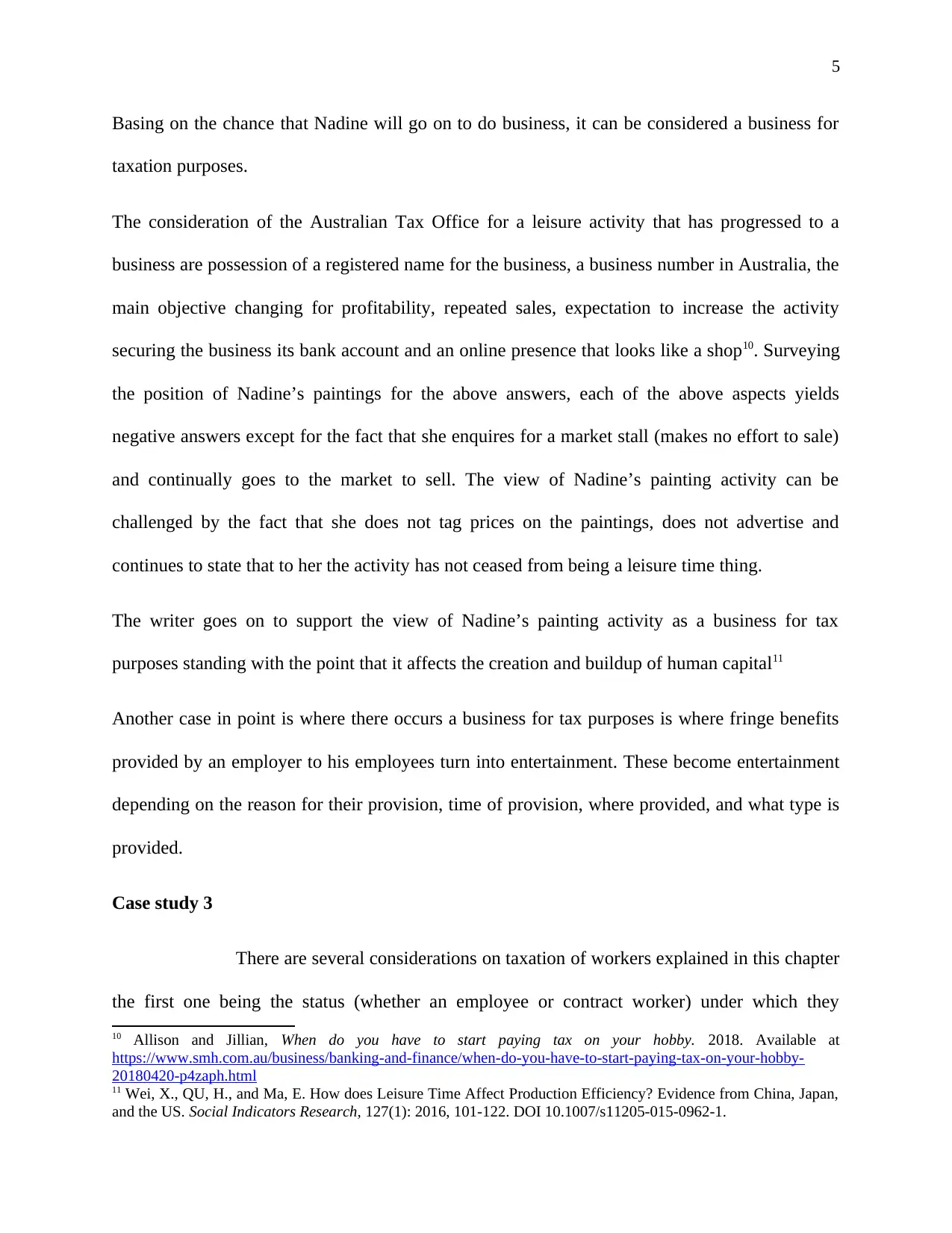
5
Basing on the chance that Nadine will go on to do business, it can be considered a business for
taxation purposes.
The consideration of the Australian Tax Office for a leisure activity that has progressed to a
business are possession of a registered name for the business, a business number in Australia, the
main objective changing for profitability, repeated sales, expectation to increase the activity
securing the business its bank account and an online presence that looks like a shop10. Surveying
the position of Nadine’s paintings for the above answers, each of the above aspects yields
negative answers except for the fact that she enquires for a market stall (makes no effort to sale)
and continually goes to the market to sell. The view of Nadine’s painting activity can be
challenged by the fact that she does not tag prices on the paintings, does not advertise and
continues to state that to her the activity has not ceased from being a leisure time thing.
The writer goes on to support the view of Nadine’s painting activity as a business for tax
purposes standing with the point that it affects the creation and buildup of human capital11
Another case in point is where there occurs a business for tax purposes is where fringe benefits
provided by an employer to his employees turn into entertainment. These become entertainment
depending on the reason for their provision, time of provision, where provided, and what type is
provided.
Case study 3
There are several considerations on taxation of workers explained in this chapter
the first one being the status (whether an employee or contract worker) under which they
10 Allison and Jillian, When do you have to start paying tax on your hobby. 2018. Available at
https://www.smh.com.au/business/banking-and-finance/when-do-you-have-to-start-paying-tax-on-your-hobby-
20180420-p4zaph.html
11 Wei, X., QU, H., and Ma, E. How does Leisure Time Affect Production Efficiency? Evidence from China, Japan,
and the US. Social Indicators Research, 127(1): 2016, 101-122. DOI 10.1007/s11205-015-0962-1.
Basing on the chance that Nadine will go on to do business, it can be considered a business for
taxation purposes.
The consideration of the Australian Tax Office for a leisure activity that has progressed to a
business are possession of a registered name for the business, a business number in Australia, the
main objective changing for profitability, repeated sales, expectation to increase the activity
securing the business its bank account and an online presence that looks like a shop10. Surveying
the position of Nadine’s paintings for the above answers, each of the above aspects yields
negative answers except for the fact that she enquires for a market stall (makes no effort to sale)
and continually goes to the market to sell. The view of Nadine’s painting activity can be
challenged by the fact that she does not tag prices on the paintings, does not advertise and
continues to state that to her the activity has not ceased from being a leisure time thing.
The writer goes on to support the view of Nadine’s painting activity as a business for tax
purposes standing with the point that it affects the creation and buildup of human capital11
Another case in point is where there occurs a business for tax purposes is where fringe benefits
provided by an employer to his employees turn into entertainment. These become entertainment
depending on the reason for their provision, time of provision, where provided, and what type is
provided.
Case study 3
There are several considerations on taxation of workers explained in this chapter
the first one being the status (whether an employee or contract worker) under which they
10 Allison and Jillian, When do you have to start paying tax on your hobby. 2018. Available at
https://www.smh.com.au/business/banking-and-finance/when-do-you-have-to-start-paying-tax-on-your-hobby-
20180420-p4zaph.html
11 Wei, X., QU, H., and Ma, E. How does Leisure Time Affect Production Efficiency? Evidence from China, Japan,
and the US. Social Indicators Research, 127(1): 2016, 101-122. DOI 10.1007/s11205-015-0962-1.
⊘ This is a preview!⊘
Do you want full access?
Subscribe today to unlock all pages.

Trusted by 1+ million students worldwide
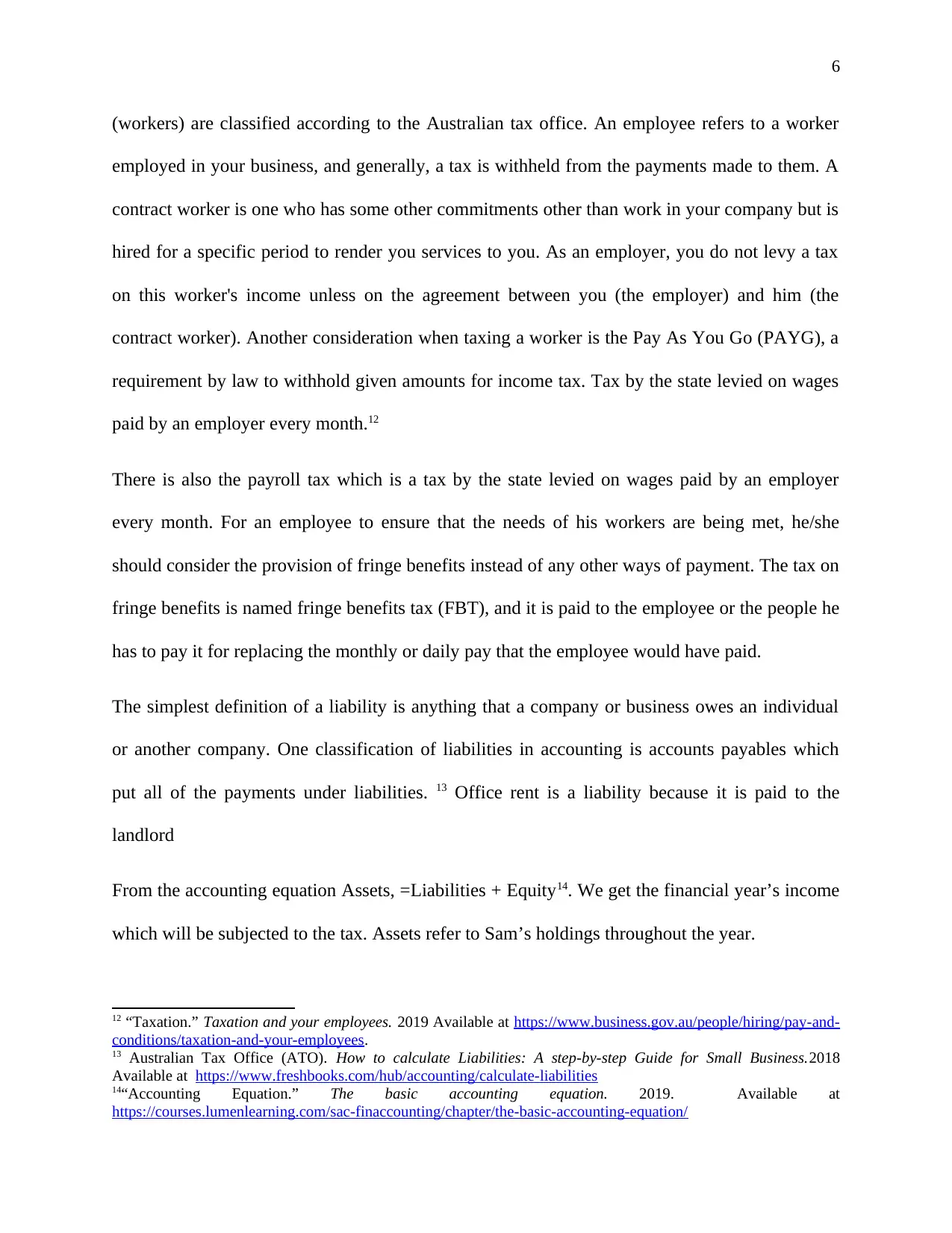
6
(workers) are classified according to the Australian tax office. An employee refers to a worker
employed in your business, and generally, a tax is withheld from the payments made to them. A
contract worker is one who has some other commitments other than work in your company but is
hired for a specific period to render you services to you. As an employer, you do not levy a tax
on this worker's income unless on the agreement between you (the employer) and him (the
contract worker). Another consideration when taxing a worker is the Pay As You Go (PAYG), a
requirement by law to withhold given amounts for income tax. Tax by the state levied on wages
paid by an employer every month.12
There is also the payroll tax which is a tax by the state levied on wages paid by an employer
every month. For an employee to ensure that the needs of his workers are being met, he/she
should consider the provision of fringe benefits instead of any other ways of payment. The tax on
fringe benefits is named fringe benefits tax (FBT), and it is paid to the employee or the people he
has to pay it for replacing the monthly or daily pay that the employee would have paid.
The simplest definition of a liability is anything that a company or business owes an individual
or another company. One classification of liabilities in accounting is accounts payables which
put all of the payments under liabilities. 13 Office rent is a liability because it is paid to the
landlord
From the accounting equation Assets, =Liabilities + Equity14. We get the financial year’s income
which will be subjected to the tax. Assets refer to Sam’s holdings throughout the year.
12 “Taxation.” Taxation and your employees. 2019 Available at https://www.business.gov.au/people/hiring/pay-and-
conditions/taxation-and-your-employees.
13 Australian Tax Office (ATO). How to calculate Liabilities: A step-by-step Guide for Small Business.2018
Available at https://www.freshbooks.com/hub/accounting/calculate-liabilities
14“Accounting Equation.” The basic accounting equation. 2019. Available at
https://courses.lumenlearning.com/sac-finaccounting/chapter/the-basic-accounting-equation/
(workers) are classified according to the Australian tax office. An employee refers to a worker
employed in your business, and generally, a tax is withheld from the payments made to them. A
contract worker is one who has some other commitments other than work in your company but is
hired for a specific period to render you services to you. As an employer, you do not levy a tax
on this worker's income unless on the agreement between you (the employer) and him (the
contract worker). Another consideration when taxing a worker is the Pay As You Go (PAYG), a
requirement by law to withhold given amounts for income tax. Tax by the state levied on wages
paid by an employer every month.12
There is also the payroll tax which is a tax by the state levied on wages paid by an employer
every month. For an employee to ensure that the needs of his workers are being met, he/she
should consider the provision of fringe benefits instead of any other ways of payment. The tax on
fringe benefits is named fringe benefits tax (FBT), and it is paid to the employee or the people he
has to pay it for replacing the monthly or daily pay that the employee would have paid.
The simplest definition of a liability is anything that a company or business owes an individual
or another company. One classification of liabilities in accounting is accounts payables which
put all of the payments under liabilities. 13 Office rent is a liability because it is paid to the
landlord
From the accounting equation Assets, =Liabilities + Equity14. We get the financial year’s income
which will be subjected to the tax. Assets refer to Sam’s holdings throughout the year.
12 “Taxation.” Taxation and your employees. 2019 Available at https://www.business.gov.au/people/hiring/pay-and-
conditions/taxation-and-your-employees.
13 Australian Tax Office (ATO). How to calculate Liabilities: A step-by-step Guide for Small Business.2018
Available at https://www.freshbooks.com/hub/accounting/calculate-liabilities
14“Accounting Equation.” The basic accounting equation. 2019. Available at
https://courses.lumenlearning.com/sac-finaccounting/chapter/the-basic-accounting-equation/
Paraphrase This Document
Need a fresh take? Get an instant paraphrase of this document with our AI Paraphraser
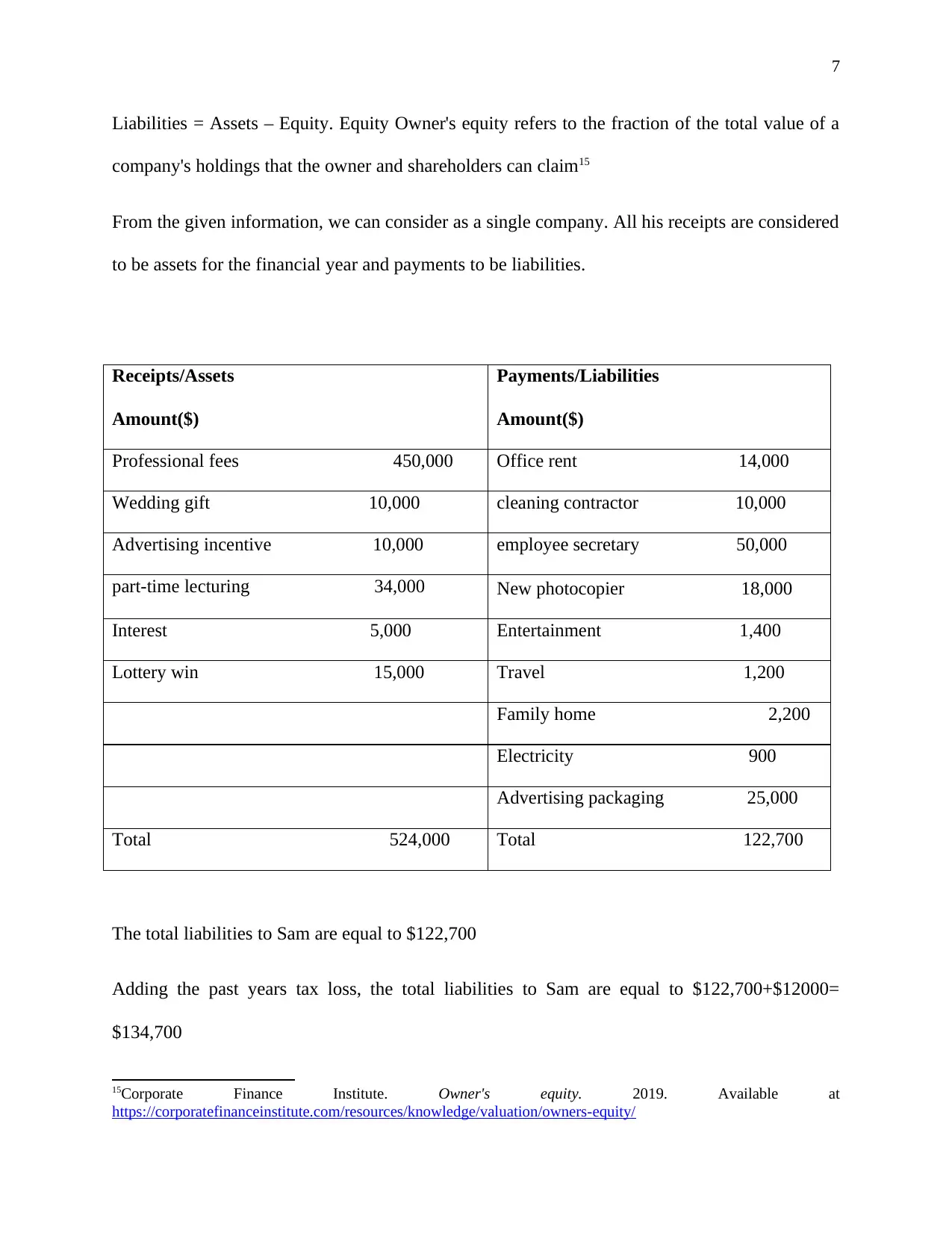
7
Liabilities = Assets – Equity. Equity Owner's equity refers to the fraction of the total value of a
company's holdings that the owner and shareholders can claim15
From the given information, we can consider as a single company. All his receipts are considered
to be assets for the financial year and payments to be liabilities.
Receipts/Assets
Amount($)
Payments/Liabilities
Amount($)
Professional fees 450,000 Office rent 14,000
Wedding gift 10,000 cleaning contractor 10,000
Advertising incentive 10,000 employee secretary 50,000
part-time lecturing 34,000 New photocopier 18,000
Interest 5,000 Entertainment 1,400
Lottery win 15,000 Travel 1,200
Family home 2,200
Electricity 900
Advertising packaging 25,000
Total 524,000 Total 122,700
The total liabilities to Sam are equal to $122,700
Adding the past years tax loss, the total liabilities to Sam are equal to $122,700+$12000=
$134,700
15Corporate Finance Institute. Owner's equity. 2019. Available at
https://corporatefinanceinstitute.com/resources/knowledge/valuation/owners-equity/
Liabilities = Assets – Equity. Equity Owner's equity refers to the fraction of the total value of a
company's holdings that the owner and shareholders can claim15
From the given information, we can consider as a single company. All his receipts are considered
to be assets for the financial year and payments to be liabilities.
Receipts/Assets
Amount($)
Payments/Liabilities
Amount($)
Professional fees 450,000 Office rent 14,000
Wedding gift 10,000 cleaning contractor 10,000
Advertising incentive 10,000 employee secretary 50,000
part-time lecturing 34,000 New photocopier 18,000
Interest 5,000 Entertainment 1,400
Lottery win 15,000 Travel 1,200
Family home 2,200
Electricity 900
Advertising packaging 25,000
Total 524,000 Total 122,700
The total liabilities to Sam are equal to $122,700
Adding the past years tax loss, the total liabilities to Sam are equal to $122,700+$12000=
$134,700
15Corporate Finance Institute. Owner's equity. 2019. Available at
https://corporatefinanceinstitute.com/resources/knowledge/valuation/owners-equity/
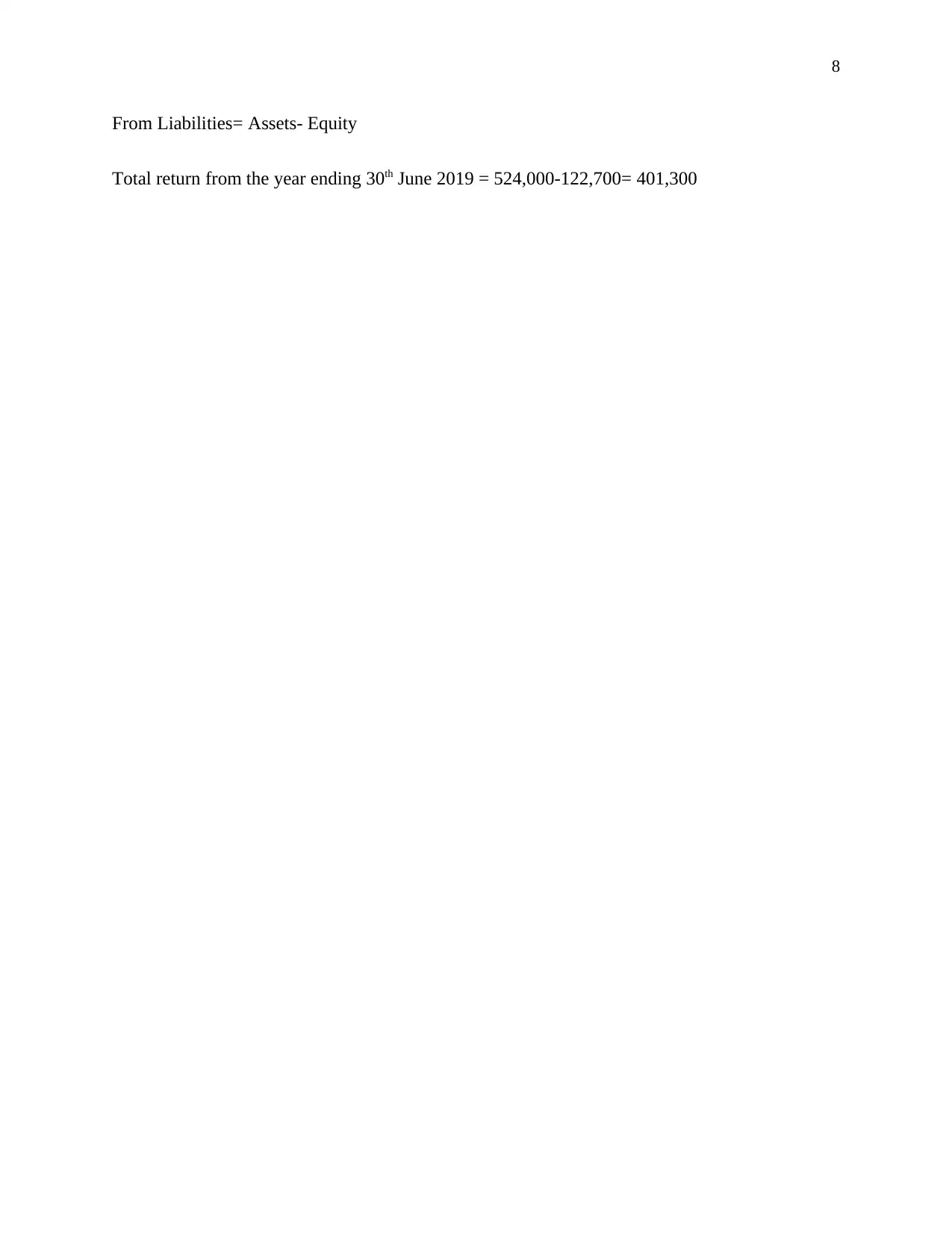
8
From Liabilities= Assets- Equity
Total return from the year ending 30th June 2019 = 524,000-122,700= 401,300
From Liabilities= Assets- Equity
Total return from the year ending 30th June 2019 = 524,000-122,700= 401,300
⊘ This is a preview!⊘
Do you want full access?
Subscribe today to unlock all pages.

Trusted by 1+ million students worldwide
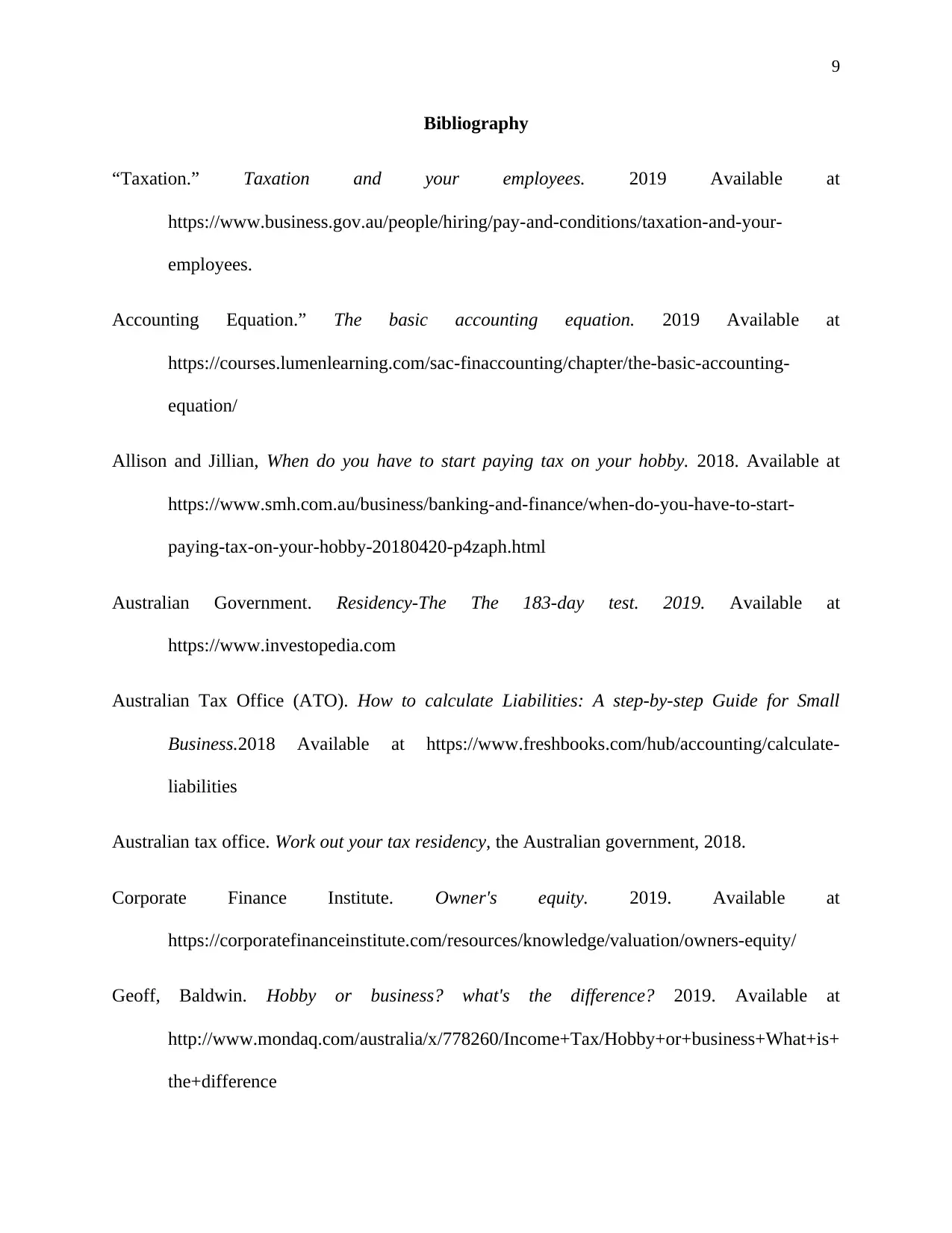
9
Bibliography
“Taxation.” Taxation and your employees. 2019 Available at
https://www.business.gov.au/people/hiring/pay-and-conditions/taxation-and-your-
employees.
Accounting Equation.” The basic accounting equation. 2019 Available at
https://courses.lumenlearning.com/sac-finaccounting/chapter/the-basic-accounting-
equation/
Allison and Jillian, When do you have to start paying tax on your hobby. 2018. Available at
https://www.smh.com.au/business/banking-and-finance/when-do-you-have-to-start-
paying-tax-on-your-hobby-20180420-p4zaph.html
Australian Government. Residency-The The 183-day test. 2019. Available at
https://www.investopedia.com
Australian Tax Office (ATO). How to calculate Liabilities: A step-by-step Guide for Small
Business.2018 Available at https://www.freshbooks.com/hub/accounting/calculate-
liabilities
Australian tax office. Work out your tax residency, the Australian government, 2018.
Corporate Finance Institute. Owner's equity. 2019. Available at
https://corporatefinanceinstitute.com/resources/knowledge/valuation/owners-equity/
Geoff, Baldwin. Hobby or business? what's the difference? 2019. Available at
http://www.mondaq.com/australia/x/778260/Income+Tax/Hobby+or+business+What+is+
the+difference
Bibliography
“Taxation.” Taxation and your employees. 2019 Available at
https://www.business.gov.au/people/hiring/pay-and-conditions/taxation-and-your-
employees.
Accounting Equation.” The basic accounting equation. 2019 Available at
https://courses.lumenlearning.com/sac-finaccounting/chapter/the-basic-accounting-
equation/
Allison and Jillian, When do you have to start paying tax on your hobby. 2018. Available at
https://www.smh.com.au/business/banking-and-finance/when-do-you-have-to-start-
paying-tax-on-your-hobby-20180420-p4zaph.html
Australian Government. Residency-The The 183-day test. 2019. Available at
https://www.investopedia.com
Australian Tax Office (ATO). How to calculate Liabilities: A step-by-step Guide for Small
Business.2018 Available at https://www.freshbooks.com/hub/accounting/calculate-
liabilities
Australian tax office. Work out your tax residency, the Australian government, 2018.
Corporate Finance Institute. Owner's equity. 2019. Available at
https://corporatefinanceinstitute.com/resources/knowledge/valuation/owners-equity/
Geoff, Baldwin. Hobby or business? what's the difference? 2019. Available at
http://www.mondaq.com/australia/x/778260/Income+Tax/Hobby+or+business+What+is+
the+difference
Paraphrase This Document
Need a fresh take? Get an instant paraphrase of this document with our AI Paraphraser
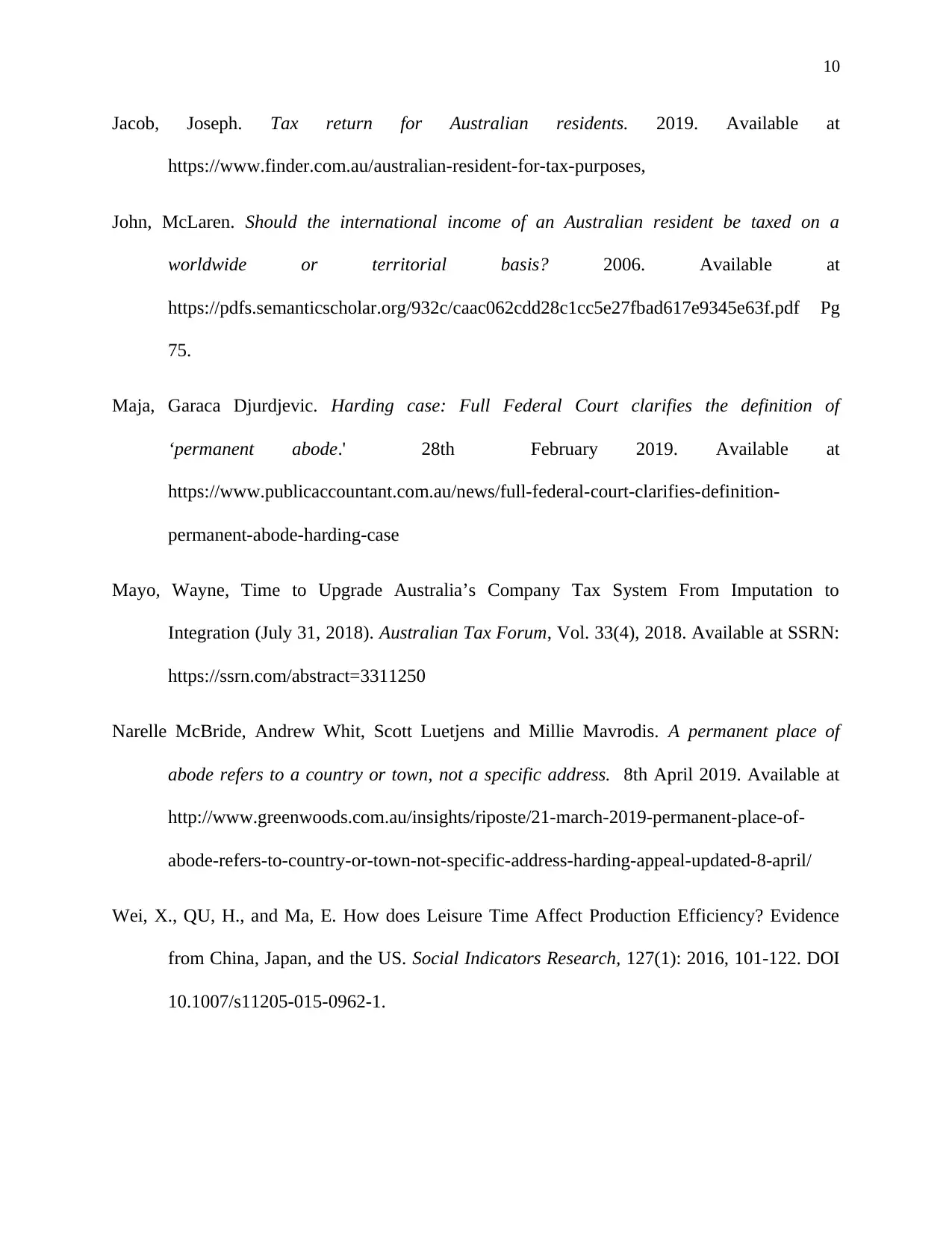
10
Jacob, Joseph. Tax return for Australian residents. 2019. Available at
https://www.finder.com.au/australian-resident-for-tax-purposes,
John, McLaren. Should the international income of an Australian resident be taxed on a
worldwide or territorial basis? 2006. Available at
https://pdfs.semanticscholar.org/932c/caac062cdd28c1cc5e27fbad617e9345e63f.pdf Pg
75.
Maja, Garaca Djurdjevic. Harding case: Full Federal Court clarifies the definition of
‘permanent abode.' 28th February 2019. Available at
https://www.publicaccountant.com.au/news/full-federal-court-clarifies-definition-
permanent-abode-harding-case
Mayo, Wayne, Time to Upgrade Australia’s Company Tax System From Imputation to
Integration (July 31, 2018). Australian Tax Forum, Vol. 33(4), 2018. Available at SSRN:
https://ssrn.com/abstract=3311250
Narelle McBride, Andrew Whit, Scott Luetjens and Millie Mavrodis. A permanent place of
abode refers to a country or town, not a specific address. 8th April 2019. Available at
http://www.greenwoods.com.au/insights/riposte/21-march-2019-permanent-place-of-
abode-refers-to-country-or-town-not-specific-address-harding-appeal-updated-8-april/
Wei, X., QU, H., and Ma, E. How does Leisure Time Affect Production Efficiency? Evidence
from China, Japan, and the US. Social Indicators Research, 127(1): 2016, 101-122. DOI
10.1007/s11205-015-0962-1.
Jacob, Joseph. Tax return for Australian residents. 2019. Available at
https://www.finder.com.au/australian-resident-for-tax-purposes,
John, McLaren. Should the international income of an Australian resident be taxed on a
worldwide or territorial basis? 2006. Available at
https://pdfs.semanticscholar.org/932c/caac062cdd28c1cc5e27fbad617e9345e63f.pdf Pg
75.
Maja, Garaca Djurdjevic. Harding case: Full Federal Court clarifies the definition of
‘permanent abode.' 28th February 2019. Available at
https://www.publicaccountant.com.au/news/full-federal-court-clarifies-definition-
permanent-abode-harding-case
Mayo, Wayne, Time to Upgrade Australia’s Company Tax System From Imputation to
Integration (July 31, 2018). Australian Tax Forum, Vol. 33(4), 2018. Available at SSRN:
https://ssrn.com/abstract=3311250
Narelle McBride, Andrew Whit, Scott Luetjens and Millie Mavrodis. A permanent place of
abode refers to a country or town, not a specific address. 8th April 2019. Available at
http://www.greenwoods.com.au/insights/riposte/21-march-2019-permanent-place-of-
abode-refers-to-country-or-town-not-specific-address-harding-appeal-updated-8-april/
Wei, X., QU, H., and Ma, E. How does Leisure Time Affect Production Efficiency? Evidence
from China, Japan, and the US. Social Indicators Research, 127(1): 2016, 101-122. DOI
10.1007/s11205-015-0962-1.
1 out of 11
Related Documents
Your All-in-One AI-Powered Toolkit for Academic Success.
+13062052269
info@desklib.com
Available 24*7 on WhatsApp / Email
![[object Object]](/_next/static/media/star-bottom.7253800d.svg)
Unlock your academic potential
Copyright © 2020–2025 A2Z Services. All Rights Reserved. Developed and managed by ZUCOL.





